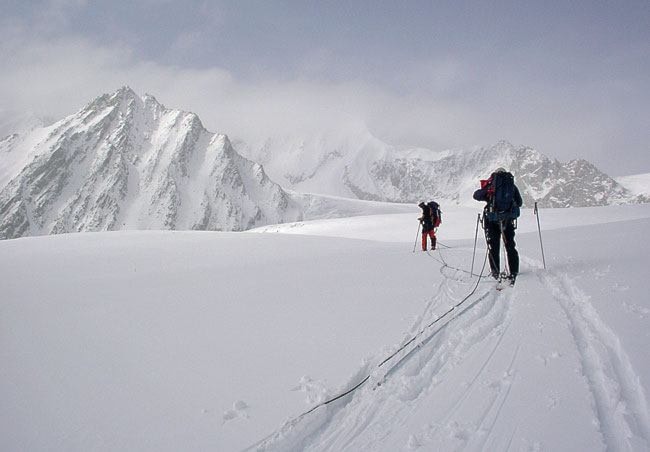Gwenn Flowers bears the stress of handling the safety of her crew as they navigate between some of Canada’s largest peaks on skis.
But she’s not a mountaineer.
She’s a scientist.
Flowers has been working on a St. Elias glacier research program in Kluane National Park and Reserve for 10 years. The research hopes to fill in a missing puzzle piece of our understanding of how quickly the region’s glaciers are melting as the world warms.
The average temperature in the Yukon has increased by two degrees in the last 50 years - double the global average. That’s meant a glacial cover loss of nearly one-quarter, contributing to more than one millimetre of global sea-level rise, according to the Northern Climate ExChange at Yukon College
As well, 60 per cent of the river flow throughout the Yukon is due to snowfall, so the fate of the territory’s shrinking glaciers could have a big impact on Yukoners in the future.
Typically Flowers’ team sets up its camps in the summer months, but this year’s research ushers them into the deep spring snow of the glaciers.
Their task? Measure winter snow accumulation at its highest point between some of the most extensive networks of icefields in the world.
Flowers’ team of four researchers have dropped in by helicopter, strapped on skis and slugged their heavy backpacks full of camp and field gear to conduct research for the next couple of weeks.
The amount of funds her team receives from research grants does not allow them to hire a guide.
“That would be my dream. If I had a big budget I would actually hire a safety person,” Flowers says with a laugh. “But we do that ourselves.”
Glacier travel and crevasse rescue are her main concerns, she says.
“We are going to multiple new sites where we don’t know the geography as well. We don’t know where the crevasses are, so it will be new terrain for us.
“The good news is the snow in spring tends to be dry and strong, so the snow itself is much safer than middle of the summer snow that’s really warm and weak,” she says.
“But yeah, you actually have to be a good survival skier.”
Her team maneuvers alongside safety ropes, pulling heavy equipment.
“You don’t actually have to be a beautiful skier, but you need to be able to stay upright with lots of stuff tied to you in different awkward ways,” she says.
It was a ski trip that first got the Colorado native hooked on glaciology. She began her studies in physics and enrolled in a glaciology class as an easy credit.
In fact, it was much more challenging than she thought.
“It’s just an awesome application of physics and math to problems of environmental science.”
She’s been absorbed in Kluane glacier fieldwork since the 1990s.
Flowers and her team are looking at the health of glaciers, what they call “glacier mass balance.”
“Much like a bank account where you would compare inputs and outputs, we can observe glacier health by seeing how they are gaining mass and losing mass.
“As we all know the glaciers are generally losing mass. But what we would like to do is to better understand the physics of the losses and gains, so that we can then create computer models to predict these on much larger scales,” she explains.
Weather station data cannot predict the complex patterns of snow gain because precipitation is patchy and hard to estimate on a large-scale.
That’s why this new project measures the highest points of winter snow accumulation out on the field, where past research is more lacking.
Logistics and planning take up a large amount of the team’s time. Their work requires aircraft landing and mountaineering permits, Parks Canada permits and permission and cooperation of the Kluane First Nations.
“When we finally get to taking the measurements it’s really exciting,” she says.
Flowers is working to increase involvement with the Kluane First Nation, especially students and young people in the community who might be interested in the science of their own backyard. They are also collaborating on place names, as many of the glaciers are unidentified.
Find out more at the Kluane Lake Research station website: http://arctic.ucalgary.ca/kluane-lake-research-station
Contact Lauren Kaljur at
lauren.kaljur@yukon-news.com
